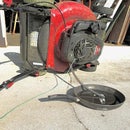Introduction: Golf Ball Return -- Putting Practice
We gave our grandson a common battery powered golf ball return for putting practice. It was on a close out and did not work when my wife got it home. I got it to work. (The spring was not anchored on one end.) But, a few days later the post for a gear shaft broke off and fine teeth on a nylon gear bent beyond repair.
I considered replacing the mechanism with an electrical actuator solenoid. While I was weighing a number of questions about what would be needed I wondered if I could make a successful ball return device based on gravity alone to power it. After building my idea, I discovered the momentum of the ball worked even better than gravity for retuning the ball.
The photo shows a real child size putter, a regulation golf ball, and the ball return device I built. It is positioned on top of a wooden toy chest in the photo, but would be on a floor surface in use. This Instructable will describe how I made it. I have appropriate scrap steel and a MIG welder, so that is what I used. My idea can easily be adapted to quarter inch plywood and woodworking tools.
Step 1: Begin With the Frame
The photo shows the underside of my ball return. I used 1 inch square tubing for the frame. The main piece is about 16 inches long. The left side of the photo is the ramp by which the ball travels onto the platform of the return device. The square tubing has been cut to taper down so it forms a gradual ramp. The tapered portion is about 12 inches long and ends where the other piece of the frame is attached at a right angle. I marked a cut line with a straight edge and a marker. Then I cut each side from the upper face (the face that meets the underside of the ramp sheetmetal) with an angle grinder and a cutting disc. Weld 6 1/2 inches of square tubing at a right angle to the main piece as shown.
Step 2: Add the Ramp Sheetmetal
I used 18 gauge steel for the ramp because It is what I had. I had a larger right triangle. I marked and cut it for a slightly smaller isosceles triangle. The base of the isosceles triangle is 5 inches. That is the front edge of the ramp. The isosceles triangle was long enough that it is almost 3 inches wide at the top of the ramp. A golf ball is just a bit less than 2 inches in diameter. The user’s aim needs to be good enough to keep the golf ball on the ramp. (I am not a golfer.)
The ramp needs to extend to the left in the photo beyond the thin end of the tapered 1 inch tubing so it meets the floor surface without creating a ridge the ball must hop over. You want to preserve the ball’s momentum for its return action. See the second photo. I used a file, and also my grinder with a flap disc to taper the front edge of the ramp. Dragging the file perpendicular to the edge of the ramp on the underside gives the best result. I used the flap disc on the grinder to remove rusting on the metal.
I welded the ramp to the tapered portion of the 1 inch tubing. See the third photo.
Step 3: The Rest of the Platform Sheetmetal
Unfortunately, I did not have more 18 gauge sheetmetal and had to finish with 20 gauge sheetmetal. I did not want ridges that might slow the ball. I clamped my assembly upside down to flat aluminum angle and clamped it to get as flush a top surface as possible. (The finished version of the ball return is a revised plan. The original version had an elevation of 2 inches because I thought the ball would need to roll down a steep ramp to gain momentum, but the momentum comes from the velocity of the ball coming out of the formed curved barrier. You can see risers I later cut off. My grandson complained he needed too much force on the ball to make it climb the 2 inch high ramp. I reduced that to 1 inch.)
Step 4: Round the Sheetmetal Platform
In this photo you can see the two pieces that form the platform surface for the ball at the top of the ramp. The radius of the curve is a strong 4 inches. I located the center and used a compass to mark a half circle. Then I cut away excess sheetmetal to leave a semi-circle.
Step 5: Add the Curved Barrier
I cut a strip of 20 gauge sheetmetal. After measuring I determined it needed to be 14 inches long. The strip is 2 inches wide. I began at the end where the ball leaves the semi-circle platform and tack welded the strip to the semi-circle as I went. I went over my golf ball return and smoother sharp corners.
This golf ball return works very well. It requires no batteries. If the ball lacks momentum to return fully, position the return device so you are putting very slightly uphill. Additional gravity from that situation will assist in returning the ball to you.
I expected my grandson would want me to apply green paint or green contact paper, but he seems very content with his new golf ball return as it is.











